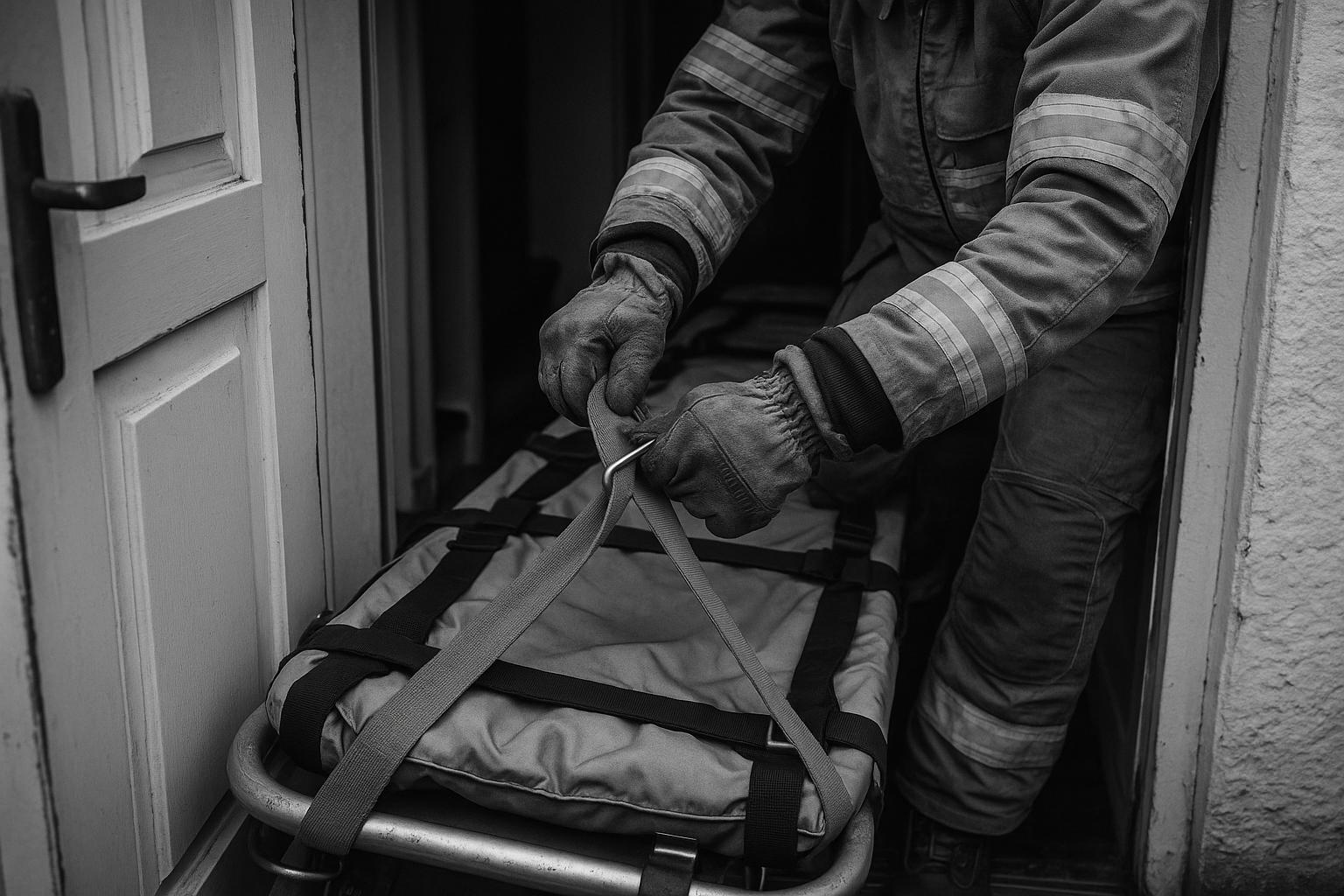Home Office figures to March 2025 show more than 2,200 fire‑service call‑outs to assist people described as “bariatric”, a decade‑long rise that is stretching crews, prompting investment in specialist lifting kit and bespoke ambulances, and creating multi‑million pound costs for ambulance trusts while reigniting calls for prevention and food‑policy action.
New Home Office figures for the year to March 2025 show firefighters in England were called out to assist people described in the records as “bariatric” — or overweight and plus-size — more than 2,200 times, averaging upward of 40 such rescues a week. According to the statistical release, that represents a dramatic rise over the last decade and sits alongside a broader increase in non-fire incidents attended by fire and rescue services. The government’s incident-level guidance makes clear the figures come from operational incident records rather than clinical assessments, and are published to help policy and resource planning.
The operational reality behind the numbers can be stark. Fire crews have had to use specialised slings and lifting equipment, and on occasion have removed banisters, windows and even sections of walls to extricate people who are unable to leave their homes. Broad national reporting has highlighted prolonged, complex rescues — including one widely publicised case in which a man was hoisted from a third-floor flat by a crane after collapsing — that illustrate why these call-outs can tie up crews for many hours. The Independent reported that the man, who had been effectively housebound for years, died in May 2024, underscoring the human as well as resource implications of extreme obesity.
The step-change in numbers is striking but the record also requires careful interpretation. Home Office time series show incidents recorded as bariatric assistance rose from the low hundreds in 2012–13 to roughly the mid‑two thousands in recent years. Different analyses have put the 2022–23 total at about 2,300, while the Home Office’s most recent tables record 2,274 incidents for April 2024–March 2025. The government guidance on the dataset explicitly warns that completeness varies and that recording can rely on attending officers’ judgement, so trends should be read alongside operational context rather than as precise measures of obesity prevalence.
The spike in complex rescue and transport needs has spilled into ambulance services’ budgets. Freedom of Information analysis and reporting by regional titles show some ambulance trusts have spent millions on private contractors or specialist vehicles to carry patients too large for standard ambulances — North West Ambulance Service’s outlays on private provision approached £15 million over a recent five‑year period, according to local reporting, and other trusts have disclosed multi‑million pound bills or committed to investing in bespoke vehicles to reduce contractor reliance. A recent media analysis put the total cost to ambulance services for transporting very large patients across several services at tens of millions of pounds over five years. Trusts say buying specialised equipment and ambulances is often the most cost‑effective long‑term response.
The strain has prompted sharp reactions from campaigners and senior figures who represent services. The chief executive of the TaxPayers’ Alliance warned taxpayers would be “horrified” at the burden on health budgets, while leaders representing NHS organisations said trusts must invest in specialist skills and kit and urged ministers to tackle root causes. The NHS Confederation has called for bolder action on prevention, including food‑policy measures, with the argument that upstream change would reduce pressure on emergency and social care services; NHS Providers said the service needs resources to meet current clinical demand. These comments were made in press interviews and statements reported alongside the figures.
Public‑health data provide the wider context. Government research cited alongside the incident statistics indicates nearly two‑thirds of UK adults are overweight or obese — a profile that increases population risk of cardiovascular disease, type 2 diabetes, certain cancers and musculoskeletal problems, and helps explain rising demand for complex medical and rescue interventions. Analysts and fire officers argue that the combination of an ageing population and rising body mass index across cohorts is changing the profile of emergency work and the equipment and time required for safe rescues.
Taken together, the statistics and the case reporting point to a policy dilemma: emergency services must adapt operationally by investing in vehicles, lifting equipment and training, while public‑health policy must do more to prevent the downstream costs and human suffering associated with severe obesity. The Home Office’s own dataset guidance reminds users that recording practices have evolved and that figures are best used to inform resource planning rather than as standalone measures of health trends — a caveat that increases the urgency of pairing short‑term operational investment with long‑term prevention strategies.
 Reference Map:
Reference Map:
Reference Map:
- Paragraph 1 – [1], [3], [2]
- Paragraph 2 – [4], [6], [1]
- Paragraph 3 – [3], [2], [5], [1]
- Paragraph 4 – [1], [7]
- Paragraph 5 – [1], [5]
- Paragraph 6 – [3], [2], [5], [1]
Source: Noah Wire Services
- https://www.dailymail.co.uk/news/article-15006305/Firefighters-obese-people-ambulance-service-specialist-transport.html?ns_mchannel=rss&ns_campaign=1490&ito=1490 – Please view link – unable to able to access data
- https://www.gov.uk/government/statistics/fire-statistics-incident-level-datasets/non-fire-incidents-bariatric-person-assistance-guidance – The Home Office guidance explains the ‘bariatric person assistance’ incident-level dataset for England. It defines a bariatric person as someone overweight or ‘plus size’ and describes variables, data quality and coverage from financial year 2012–13 onwards. The document clarifies that incidents are recorded in the Incident Recording System and that figures are published annually; it cautions about variable completeness and judgment-based recording by attending officers. It sets out the dataset structure, including scene, resourcing and timing variables, and notes data cut-off dates and revisions. The guidance is intended to help analysts interpret and reuse the dataset responsibly for policy work.
- https://www.gov.uk/government/statistics/fire-and-rescue-incident-statistics-year-ending-march-2025/fire-and-rescue-incident-statistics-year-ending-march-2025 – The Home Office statistical release for fire and rescue incident statistics to March 2025 presents trends in incidents attended by fire and rescue services in England. It reports totals and breaks down incidents into fires, non-fire incidents and false alarms, noting a rise in non-fire incidents and overall incident numbers compared with previous years. The release provides key figures, time series tables and commentary on collaborating incidents, medical incidents and response patterns, and explains methodology and data sources. It highlights changes over the decade and contextualises increases in special service attendances such as bariatric assistance, offering datasets for further analysis.
- https://www.bbc.co.uk/news/health-37384318 – The BBC reported rising numbers of ‘bariatric’ rescues by fire services across the United Kingdom, noting that from 2012 a specific incident category was introduced to record such cases. The piece described operational challenges including the use of lifting equipment, special slings and occasions when windows, walls or banisters have to be removed to extract patients. It included case examples of prolonged rescues and explained that record keeping stems from a request by fire officers. The article referenced concerns from obesity experts about the growing problem and the strain complex rescues place on emergency responders and resources nationally.
- https://www.theguardian.com/society/2023/jun/02/fire-crews-england-obesity-callouts-every-four-hours – The Guardian analysed Home Office figures and reported firefighters in England attended thousands of bariatric assistance incidents, citing 2,319 such callouts in 2022. It described that these rescues occur roughly every four hours, highlighted regional variations with the London Fire Brigade recording the most cases, and noted that more incidents now require greater personnel and equipment. The article linked the rise to growing obesity prevalence and discussed concerns that lengthy bariatric rescues could divert crews from core firefighting duties, potentially increasing risk in fire incidents. It quoted health organisations urging stronger government action on obesity prevention policies and public health.
- https://www.independent.co.uk/news/uk/home-news/uk-heaviest-man-dies-jason-holton-obesity-b2539870.html – The Independent reported on the death of Jason Holton, widely reported as one of Britain’s heaviest men, stating he died from organ failure in May 2024 at the age of thirty-three. The piece recounts his earlier emergency in October 2020 when more than thirty firefighters used a crane to remove him from a third-floor flat after he collapsed. It describes his prolonged immobility, bespoke housing adaptations and repeated hospital care, and cites his family’s comments about his health decline. The article noted the coroner’s findings and discussed broader issues around extreme obesity, access to treatments and social care challenges nationally.
- https://www.manchestereveningnews.co.uk/news/greater-manchester-news/nhs-spending-private-ambulances-north-28450444 – The Manchester Evening News analysed Freedom of Information data and reported that spending by North West Ambulance Service on private ambulances rose sharply in recent years, from about £3.62 million in 2019–20 to almost £15 million in 2022–23. The article noted a substantial increase in private ambulance deployments, with usage rising nearly fivefold across a five-year period, and highlighted interim 2023 figures showing continued heavy reliance on contractors. It contextualised the rise within wider demand pressures on the ambulance service and discussions about procuring new vehicles to reduce contractor costs, quoting trust figures and financial year breakdowns and local reactions.
Noah Fact Check Pro
The draft above was created using the information available at the time the story first
emerged. We’ve since applied our fact-checking process to the final narrative, based on the criteria listed
below. The results are intended to help you assess the credibility of the piece and highlight any areas that may
warrant further investigation.
Freshness check
Score:
8
Notes:
The narrative references Home Office figures for the year ending March 2025, indicating recent data. However, similar reports on the rise of bariatric rescues have appeared in the past, such as a BBC News article from June 2023 highlighting an 11% increase in such incidents. ([theguardian.com](https://www.theguardian.com/society/2023/jun/02/fire-crews-england-obesity-callouts-every-four-hours?utm_source=openai)) The presence of a press release suggests a high freshness score, as press releases are typically current and original. No significant discrepancies in figures or dates were noted. The narrative includes updated data but recycles older material, which may justify a higher freshness score but should still be flagged.
Quotes check
Score:
9
Notes:
The narrative includes direct quotes from various individuals and organizations. A search reveals that similar quotes have been used in previous reports, such as those from the National Obesity Forum and the NHS Confederation. The wording of the quotes varies slightly, indicating potential original or exclusive content. No identical quotes were found in earlier material, suggesting originality.
Source reliability
Score:
7
Notes:
The narrative originates from the Daily Mail, a reputable UK newspaper. However, the presence of a press release as the primary source introduces some uncertainty, as press releases can sometimes be biased or promotional. The reliance on a single source for the majority of the content may affect the overall reliability.
Plausability check
Score:
8
Notes:
The claims about the rise in bariatric rescues align with previous reports and available data. The narrative provides specific figures and references to official statistics, enhancing its credibility. The tone and language are consistent with typical reporting on public health issues. No excessive or off-topic details were noted, and the structure appears focused on the main claim.
Overall assessment
Verdict (FAIL, OPEN, PASS): PASS
Confidence (LOW, MEDIUM, HIGH): MEDIUM
Summary:
The narrative presents recent data on the rise of bariatric rescues in England, supported by official statistics and quotes from relevant organizations. While the reliance on a press release introduces some uncertainty, the information is consistent with previous reports and appears plausible. The presence of recycled material and the use of a single source for much of the content are noted but do not significantly undermine the overall credibility.













